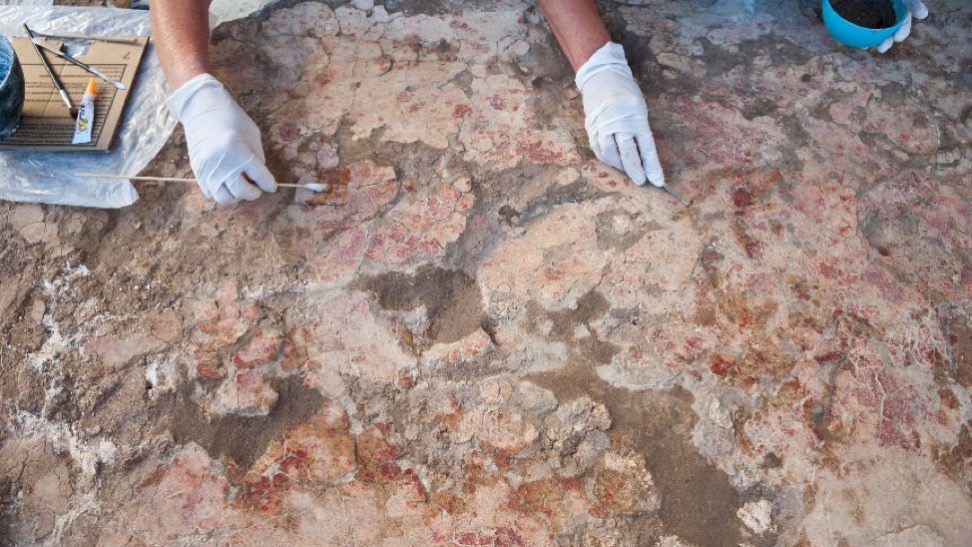
La Cueva del Mirón (Ramales de la Victoria, Cantabria): Life forms and human responses to climate change in the Tardiglaciar of the Spanish Cantabrian Region
The Cueva del Mirón has become a reference site for many different investigations, and its materials have served and are serving to develop different lines of pioneering research at each moment on stable isotopes and their application to palaeopathic studies, on physical parameters such as variations in the Earth’s magnetic field, palaeoclimatic and palaeontological studies, proteomics applied to the identification of eggshells, and genetic studies on salmon, deer and humans.

Period
Archaic Magdalenian to Superior (21,000-14,000 calBP)
Institution
International Institute of Prehistoric Research of Cantabria (IIIPC) (Universidad de Cantabria, Government of Cantabria, Banco de Santander)
Web and social networks
Principal Investigator(s)
Dr. Manuel Ramón González Morales
(IIIPC) (Universidad de Cantabria)
Co-IP: Lawrence G. Straus
University of New Mexico (USA)
Location
The Mirón Cave (Ramales de la Victoria, Cantabria)
Principal Investigator(s)
Dr. Manuel Ramón González Morales
(IIIPC) (Universidad de Cantabria)
Co-IP: Lawrence G. Straus
University of New Mexico (USA)
Location
The Mirón Cave (Ramales de la Victoria, Cantabria)
LOCATION
RESULTS
- The Miron has revealed a stratigraphic sequence of almost continuous occupation between 48,000 and 3,500 years ago, with periods of particularly dense habitation, such as the Lower Magdalenian and others of occasional frequentation. This sequence has been dated with 93 radiocarbon dates -by far the most complete set of dates for a single site in Cantabrian Prehistory-.
- It meant the excavation with modern techniques, for the first time in the Cantabrian coast, of powerful Neolithic and Chalcolithic occupation strata with activity areas and fires, remains of fauna, ceramics and lithic instruments, and 15 coherent radiocarbon dates, unique also for sites of this chronology in the Cantabrian area.
- Studies on the fauna of the first Neolithic period reveal the absolute predominance of the domestic fauna of ovicaprines over the wild one, revealing a model of fast adoption of the Neolithic in the area, in sets of smooth ceramics, without decoration.
- The strata of ashes and burnt clay beds have served, together with two Atapuerca sites, the Portalón and Mirador caves, to obtain the first paleosecular directional variation curve of the magnetic field in Europe for the Neolithic period, a future reference for researchers.
- The fauna recovered in the cave, with an excellent state of conservation, has allowed the development of detailed studies on the subsistence strategies of the human groups.
- On the other hand, this good state of conservation has allowed El Mirón to become the Spanish reference site for international studies on the genetics of Atlantic salmon and European deer, tracing the migration and colonization routes from the refuge areas during the Maximum Glacier.
- From the information of climatic type (obtained from sediments, fossil pollen, vegetal macrorrorrestos or microfauna) it has been possible to obtain indicators of detail to produce predictive spatial models of the process of vegetal recolonization of the zone at the end of the Tardiglacial and to understand better the global changes in the landscapes of the period, which in turn are the base to be able to define areas of use and routes of displacement in the past.
- It was confirmed, for the first time, the existence of occupations of the Solutrense and Gravetiense in the area, the periods to which the paintings of Covalanas are attributed today, and our dating in several of the adjacent painted or engraved caves (La Haza, La Luz, Cullalvera) proved their occupation in various moments of contemporary prehistory of the painted and engraved representations.
- The Miron has provided the most recent known testimony of the presence of Pliomys lenki, which was considered extinct thousands of years ago, in the Pleistocene.
- Finally, the discovery in 2010 of a human burial in a level of the lower Magdalenian (the Red Lady of the Cueva del Mirón), unique in the peninsula for the entire Magdalenian period, has allowed for the first time the anatomical characterization of these populations, but above all their genetic determination, with the definition of the El Mirón cluster as the main lineage of the recolonization of Europe after the Maximum Glacier and of which it is the oldest specimen.
PICTURES
- The Oldest Vanilla Pod in Europe, Used in Alchemical Experiments, Discovered at Prague Castle (La Brújula Verde 31/03/2025) - 1 April, 2025
- On the Origin of the Pork Taboo (Archaeology Magazine 31/03/2025) - 1 April, 2025
- Discovery of Quina technology challenges view of ancient human development in East Asia (Phys.org 31/03/2025) - 1 April, 2025

























